| Article ID | Journal | Published Year | Pages | File Type |
|---|---|---|---|---|
| 646184 | Applied Thermal Engineering | 2014 | 10 Pages |
•The liquid column coalescing with droplet in hydrophilic microchannel is simulated.•The coalescence with the droplet can promote the liquid column movement.•More hydrophilic surface and smaller channel size induce larger acceleration rate.•Larger droplet size and shorter droplet distance exhibit larger acceleration rate.
The dynamic behavior of the moving liquid column coalescing with a sessile droplet in a hydrophilic microchannel is simulated in this work using the volume of fluid (VOF) methodology along with the continuum surface force (CSF) model. Particular attention is paid to the dynamic interfacial phenomena during the coalescence and the effect on advancing the water–air interface. It is interesting to find that the coalescence between the moving liquid column and droplet can accelerate the original liquid column movement due to the formation of the lager-curvature meniscus at the interface induced by the coalescence, which increases the capillary pressure. In addition, effects of the wettability, the sizes of the microchannel and droplet as well as the droplet position on the coalescence behaviors and liquid column movement are also studied. The results show that more hydrophilic surface, smaller channel size and distance between the droplet and inlet, and larger droplet size exhibit a larger acceleration rate as a result of induced higher capillary pressure.
